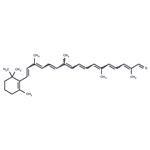Content analysis
Sample solution A: Accurately weigh about 40 mg of the sample, transfer it into a 100 ml volumetric flask, dissolve it in 10 ml of acid-free chloroform, make up to volume with cyclohexane and mix well. Pipette 2ml of this solution into a 50ml volumetric flask, dilute to volume with cyclohexane and mix well. Pipette 5ml of sample solution A into a 50ml volumetric flask with sample solution B, dilute to volume with cyclohexane and mix well. Determination step Use a suitable spectrophotometer to measure the absorbance of sample solution B in a 1CiTI absorption cell at the maximum absorption wavelength of about 460nm, and use cyclohexane as a blank test solution. Calculate the content (in mg) of this product (C30H40O) in the sample according to the formula 25000A/264, where A is the absorbance of the solution, and 264 is the absorbance coefficient of pure β-apocarcinaldehyde.
Description
trans-β-Apo-8′-carotenal is a dark purple crystal or crystalline fine powder with metallic luster. It is one of the oxidation products of carotenoids contained in citrus. It is insoluble in water and can be dispersed in hot water. It is easily soluble in chloroform, insoluble in ethanol, and slightly soluble in vegetable oil and acetone. Industrial products soluble in oils or organic solvents, with stable performance.
Chemical Properties
Fine crystalline powder with dark metal-
lic sheen or violet crystals.Sol in chlo-
roform; sltly sol in acetone; insol in water.
Uses
β-Apo-8'-carotenal is an antioxidant β-carotene (C184250) derivative found in Cucumis melo melons and traditional Portuguese fruits and vegetables. Studies have shown that β-Apo-8'-carotenal decreased
the in vivo AFB1-induced DNA SSB and the binding of AFB1 to liver DNA and increased in vitro AFB1 metabolism to aflatoxin M1, a less genotoxic metabolite.
Uses
β-apo-8 -carotenal is used to color juices, fruit drinks, soups, jams, jellies, and gelatin.
Uses
Beta-Apo-8'-Carotenal is a colorant that is a carotenoid producing a light to dark orange hue. It has fair light stability, poor oxidation stability, and good ph stability. It is insoluble in water but is available in water-dispersible, oil-dispersible, and oil-soluble forms. It has vitamin a activity. It is used in cheese and cheese sauces, and dressings. The maximum usage level is 33 ppm. Related colorants are beta-carotene and canthaxanthin.
Definition
ChEBI: An apo carotenoid triterpenoid compound arising from oxidative degradation of the beta,beta-carotene skeleton at the 8'-position.
General Description
trans-β-Apo-8′-carotenal is a linear aldehydic carotenoid. It is naturally found in oranges, spinach, grass, tangerines and marigolds and thus, it is directly absorbed from the diet.
Biochem/physiol Actions
trans-β-Apo-8′-carotenal is commercially available as a food colorant.
Safety Profile
When heated to
decomposition it emits acrid smoke and
irritating fumes.
Purification Methods
Recrystallise β-apo-8'-carotenal from CHCl3/EtOH mixture or n-hexane. [Bobrowski & Das J Org Chem 91 1210 1987, Beilstein 7 III 2622, 7 IV 1782.]
Properties and Applications
orange to yellow light red.



